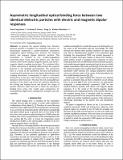Asymmetric longitudinal optical binding force between two identical dielectric particles with electric and magnetic dipolar responses
Abstract
In general, the optical binding force between identical particles is thought to be symmetric. However, we demonstrate analytically a counterintuitively asymmetric longitudinal optical binding force between two identical electric and magnetic dipolar dielectric particles. This homodimer is confined in two counterpropagating incoherent plane waves along the dimer's axis. The force consists of the electric dipolar, magnetic dipolar, and electric-magnetic dipolar coupling interactions. The combined effect of these interactions is markedly different than the expected behavior in the Rayleigh approximation. The asymmetric force is a result of the asymmetric forward and backward scattering of the particles due to the dipolar hybridization and coupling interactions. Consequently, it leads to a harmonic driving force on the pair, which decays with the interparticle distance to the first power. We show the rich nonequilibrium dynamics of the dimer and of the two particles impelled by the driving and binding forces and discuss the ranges of particle refractive index and size in which the asymmetric binding force arises. Our results open perspectives for nonequilibrium light-driven multiparticle transport and self-assembly.
Citation
Duan , X-Y , Bruce , G D , Li , F & Dholakia , K 2022 , ' Asymmetric longitudinal optical binding force between two identical dielectric particles with electric and magnetic dipolar responses ' , Physical Review A , vol. 106 , no. 1 , 013108 . https://doi.org/10.1103/PhysRevA.106.013108
Publication
Physical Review A
Status
Peer reviewed
ISSN
2469-9934Type
Journal article
Description
Funding: This work was supported by Jiaxing Science and Technology Project Grants (No.2021AY10057), KD acknowledges support of the UK Engineering and Physical Sciences Research Council (grant EP/P030017/1).Collections
Items in the St Andrews Research Repository are protected by copyright, with all rights reserved, unless otherwise indicated.

